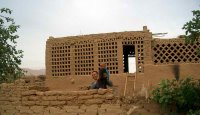 Eventually, we were able to make ourselves understood, and he drove us back into town and dropped us off. We had hoped that the town had a commercial hub, a street that might have a corner store or a local restaurant. If the village indeed had anything like that, it had long since been relocated to the tourist end of town. The rest of the village was purely residential with vineyards and orchards worked by locals who did not depend on the tourist trade for their survival.
Eventually, we were able to make ourselves understood, and he drove us back into town and dropped us off. We had hoped that the town had a commercial hub, a street that might have a corner store or a local restaurant. If the village indeed had anything like that, it had long since been relocated to the tourist end of town. The rest of the village was purely residential with vineyards and orchards worked by locals who did not depend on the tourist trade for their survival. Along the way, Will found an opening in the wall alongside the road and stepped back into one of the neighborhood vineyards to take a few photos. The rest of us followed along, cameras at the ready. Within five minutes, Will had managed to meet and strike up a cordial conversation with Mehmet, a man who worked a healthy vineyard adjacent to the rear of his home. Mehmet propped his youngest son up on the wall so we could all admire the lad and so he could see a handful of foreigners. Conversation with Mehmet was even more difficult than conversation with our driver, as Mehmet spoke only broken Chinese.
 At one point in the conversation, Mehmet turned to Michael and said, "Would you like to come in and see my house?" Michael, unsure that the man had truly just invited a cluster of foreigners into his home, turned to Will for confirmation. Will shrugged, and told Mehmet that we didn't want to trouble him. The gleam in Will's eye, however, gave him away. This was precisely the sort of opportunity that we came out to find!
At one point in the conversation, Mehmet turned to Michael and said, "Would you like to come in and see my house?" Michael, unsure that the man had truly just invited a cluster of foreigners into his home, turned to Will for confirmation. Will shrugged, and told Mehmet that we didn't want to trouble him. The gleam in Will's eye, however, gave him away. This was precisely the sort of opportunity that we came out to find!We walked around the wall that enclosed Mehmet's property and entered through the oversized gate out front, typical of Uighur residences throughout the area. Beyond the gate was a modest courtyard, most of which was occupied by two well-manicured vegetable gardens. A mud-brick walkway led us in through the open door to the main hall of his home. The main hall had a 4.5-meter/15-foot ceiling, the upper portion of which was latticed to allow breezes to ensure fresh, cool air inside the residence. The only sign of electricity within was a single 40-watt light bulb, suspended from a broomhandle that protruded from one wall.
Just past the entryway, a baby basket hung low to the floor, suspended from a rafter 4 meters (13 feet) above; with a good shove, that basket could give a kid quite a ride. Furniture was sparse: a double bed, a single cot, an end table and china cabinet, a brightly-burning clay stove, and a modest table with chairs. Most of the floorspace was open flagstone, and easily accommodated our group.

Mehmet introduced us to his wife, who brought out bowls of tea, raisins, and candies, as well as a plate of bread. It should be noted that although fresh Uighur bread is the equal of any baked good to be found in all of China, after it has had a chance to sit out and air for a while it loses any pliability it ever had. None of us was accustomed to eating hard tack like this, so it took some doing to show our appreciation for their hospitality.
Before all was said and done, Mehmet had also introduced us to his parents (who lived in the building next door) and invited us several times to stay the night at his place. Uighur generosity cannot be done justice without being experienced first-hand. For any of you who are planning trips to the Turpan area, let us know. Mehmet told us on no fewer than three occasions that we should tell our friends to stop by and take him up on his offer of dinner and lodging, particularly during the holidays.
Check back in with us here tomorrow as we share a few thoughts and photos on the neighborhood mosques.

No comments:
Post a Comment